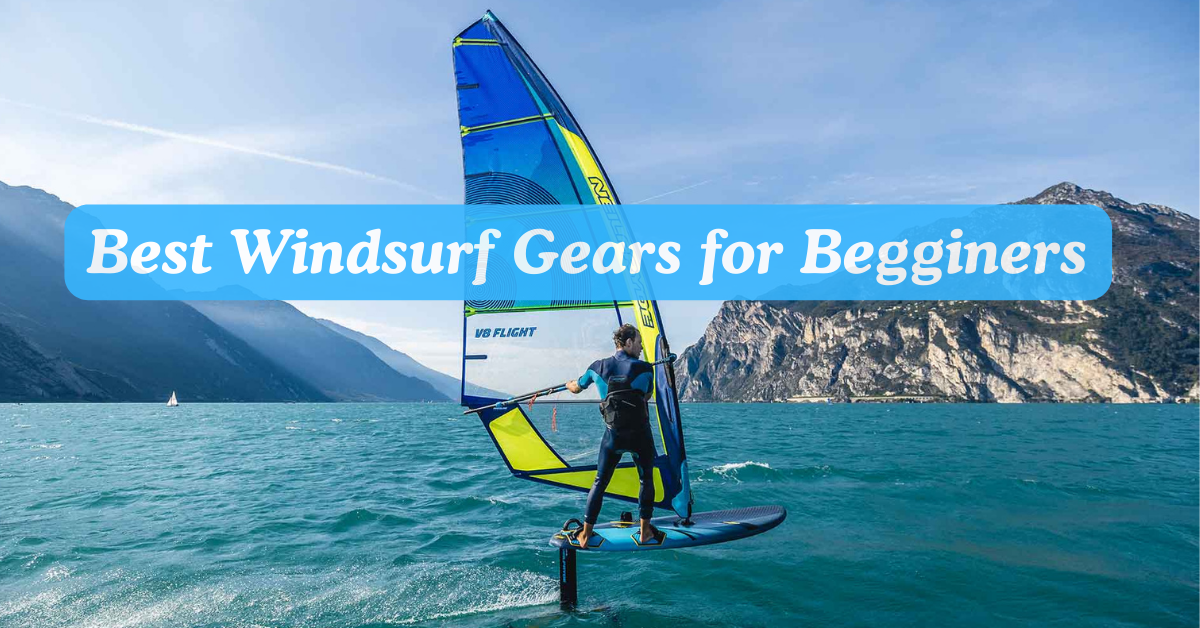The Top Windsurfing Equipment For Beginners, Think yourself riding the waves with grace and power, feeling a rush of adrenaline and a deep connection to the natural world. But for new learners, getting on the board for the first time can frightening, if they need to know which equipment suits their surf. Choosing the appropriate wind sailing equipment might be the difference between a frustrating and Amazing experience.
we’ll break down essential tips for selecting the best surfing equipment for beginners . Choosing the best windsurfing equipment can feel daunting—like trying to navigate a maze without a map.
What do you Need?
Choosing suitable equipment might mean the difference between gliding into an exploration with ease and getting frustrated and lost.
You Need Best Sailing Setup , Sail , board, mast, UpHaul, mast extension, and mast Base.
Windsurf Board – How to Choose Windsurf Board
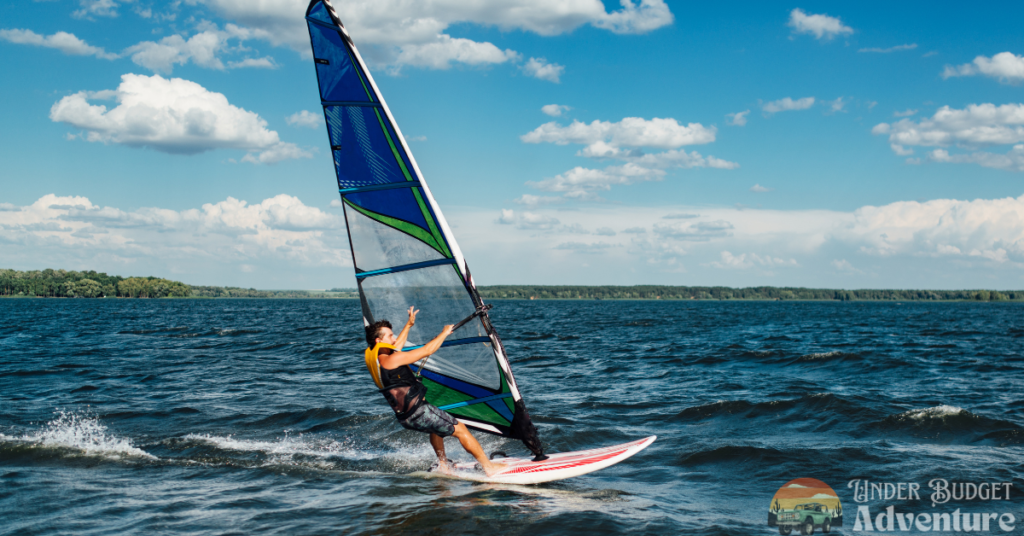
Windsurfing is not just a sport. it’s a thrilling dance between the rider and the surroundings that attract people from all over the world. However, having the suitable gear is important to fully enjoying this excitement, particularly when it comes to choosing a windsurf board that enhance your skill level and style.
The best beginner surfboards prioritize stability and buoyancy, providing a solid foundation as you navigate those initial learning curves, If your Windsurf Board is not stable , it is very difficult for you to sail on it. It is best for you that you can
Daggerboard or Center Fin
When it comes to selecting the best windsurfing gears , the choice between a daggerboard and a center fin can significantly impact your experience on the water. Dagger boards offer exceptional upwind performance, They provide added lateral resistance, allowing for smoother navigation in challenging conditions.
On the other hand, center fins shine when it comes to downwind speed and overall stability in choppy waters. Their design often promotes quicker transitions between different points of sail, enhancing your agility during dynamic sessions.
Width of Surfing Board – Best Windsurfing Boards
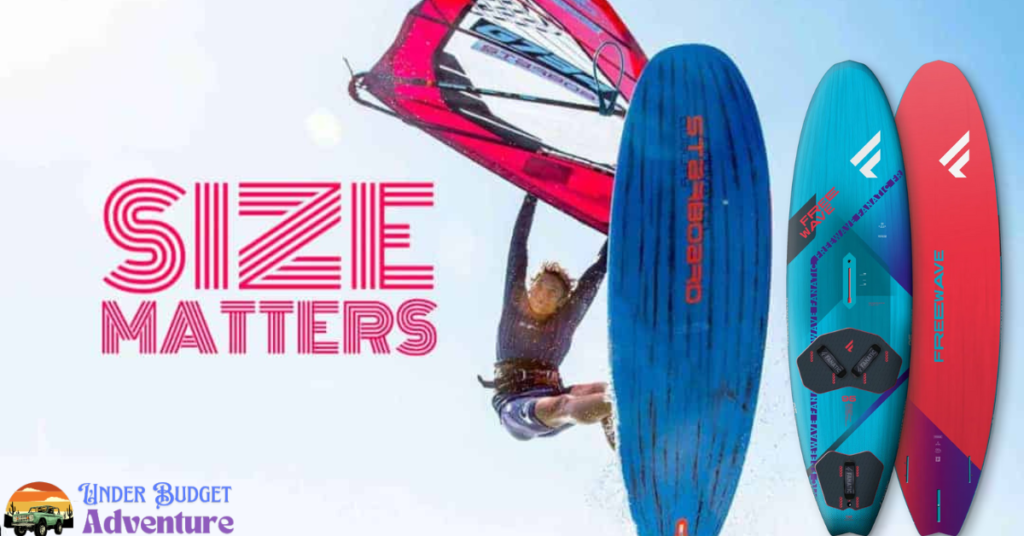
Width of the board is very important factor for beginners to think, the width of the surfboard should be atleast 70 Cm Wide or 27.5 inches. If your board is narrow you will fall on water, so it’s very important that your surfing board is wide so you can easy stand on it and surf on it.
In my past year my first board is fanatic viper , this surfing board is 24” wide. When i tried to surf i fall, and in my whole week training i fall 95% of my surfing. Then i move on to the F2 Xntos short board. This board is shorter than the earlier one, i can’t stand on much , because i am not professional surfer and want to surf like professional
Then i buy my third board Bic Techcno 293, this board is much wider almost 31” wider and 79 Cm.
I just spend few hours of learning and make better progress of my past years, i was very happy that i can surfing on boat like flying on the water
Volume of WindSurfing Boad
When selecting the best windsurfing equipment, one of the crucial aspects to consider is the volume of the surfing board. A board’s volume directly affects stability and performance. Choosing the right volume of your windsurfing board is crucial for optimizing performance on the water.
For beginners, a larger board with higher volume offers more stability and buoyancy, making it easier to catch onto the wind without feeling overwhelmed.
Opting for a lower-volume board may seem daunting at first but can significantly enhance agility and responsiveness in choppy waters or during high-speed runs. These boards allow for sharper turns and quicker adjustments, essential for those looking to refine their skills or transition into freestyle maneuvers.
Required Length of Windsurf Board

The length of the surfboard plays a crucial role in your overall experience on the water. Shorter boards, typically measuring between 7 to 9 feet, offer increased maneuverability and are ideal for advanced riders looking to execute sharp turns and dynamic tricks.
The longer boards ranging from 10 to 12 feet provide more stability and buoyancy—perfect for beginners who need that extra support while mastering their technique. This balance between length and performance can’t be overstates, selecting the right size based on skill level can significantly enhance your confidence and enjoyment on windy days.
Lightweight materials like monofilm allow for better speed without compromising durability, enabling you to harness even the gentlest breezes effectively. A well-chosen rig also boosts efficiency; look for adjustable masts which cater not only to varying wind conditions but also adapt as you progress in skill.
Foot Straps
Foot straps on your surfing board often don’t get the attention they deserve. These straps are not just simple attachments, they play a crucial role in ensuring control and stability as you navigate through choppy waters and catch those adrenaline-pumping waves. Experimenting with different positions for your foot straps can significantly impact your maneuverability and comfort, allowing you to optimize performance tailored to various conditions.
Choosing quality foot straps enhances not only safety but also overall enjoyment. Opt for models that have adjustable widths and cushioning properties, which allow for a snug fit without compromising mobility. This thoughtful design lets riders quickly adapt their stance based on skill level or conditions.
Video Guide
Rigid vs Inflatable Boards
One critical decision revolves around choosing between rigid and inflatable boards. Rigid boards are recognized for their stability and performance in various wind conditions, making them ideal for experienced sailors looking to carve tight turns and harness speed. Their solid construction allows for quick response times on the water, offering a thrilling experience that can push your skills to new heights.
Inflatable Boards present a game-changing appeal with their remarkable portability. Designed with modern materials that don’t compromise on rigidity or performance, these boards inflate quickly and pack down into manageable size, perfect for wanderers who might want to explore remote beaches without the hassle of heavy gear. You’d be surprised by how much technology has advanced in this sphere; today’s inflatables often rival traditional designs regarding responsiveness and stability
Sail Size of Windsurf Board
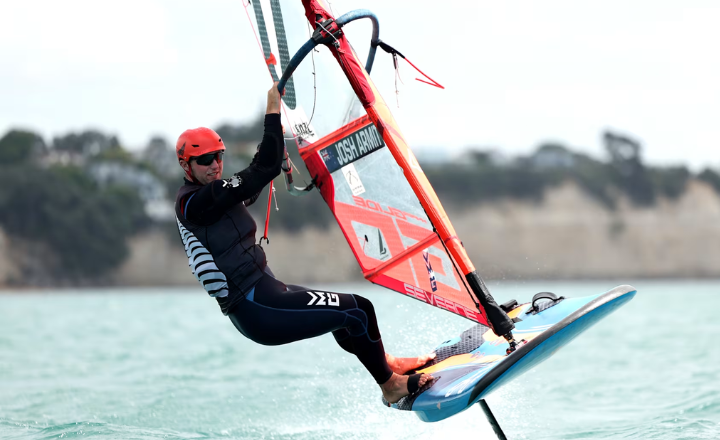
Among various factors to consider, sail size plays a pivotal role in tailoring performance to conditions and skill level. A smaller sail (4.5 to 6.0 square meters) is ideal for stronger winds, providing better control and agility, while larger sails (7.0 square meters and above) excel in lighter winds by maximizing power without sacrificing stability. Understanding how wind strength impacts your choice can transform those chaotic gusts into exhilarating rides.
No Cams or Camber Inducers
For those who crave simplicity and maneuverability, boards designed without cams or camber inducers offer a refreshing alternative. These features might typically provide extra stability at higher speeds, but by eliminating them, you gain a liberating sense of freedom and responsiveness that enhances your connection to the elements. This minimalist approach allows for quicker rigging and easier transitions from one move to another—perfect for riders looking to perfect their freestyle tricks or simply enjoy an uncomplicated session.
lightweight sail options are redefining accessibility on the waves. Newly engineered materials reduce fatigue while enhancing performance; they allow novice windsurfers to progress quickly while providing seasoned riders with high-level responsiveness. Sails void of unnecessary complexity not only lighten the load but also inspire confidence in every gust of wind.
Mast & Boom of Windsurf Board
Your mast and boom can make or break your experience on the water. The right mast establishes a solid foundation for performance; carbon masts, while pricier, provide a lighter and stiffer alternative that translates to better responsiveness and control in various wind conditions. On the other hand, fiberglass masts are often favored by beginners for their durability and cost-effectiveness.
Equally important is the boom, where comfort meets control. Look for booms with adjustable lengths that not only accommodate different sail sizes but also align with your personal grip preference—ergonomic grips can mean hours of comfortable sailing. Innovations like modular designs are changing the game too; they allow sailors to break down equipment for easy transport without sacrificing performance on the water.
Mics Parts: Mast Extention – Mast Base – Uphaul
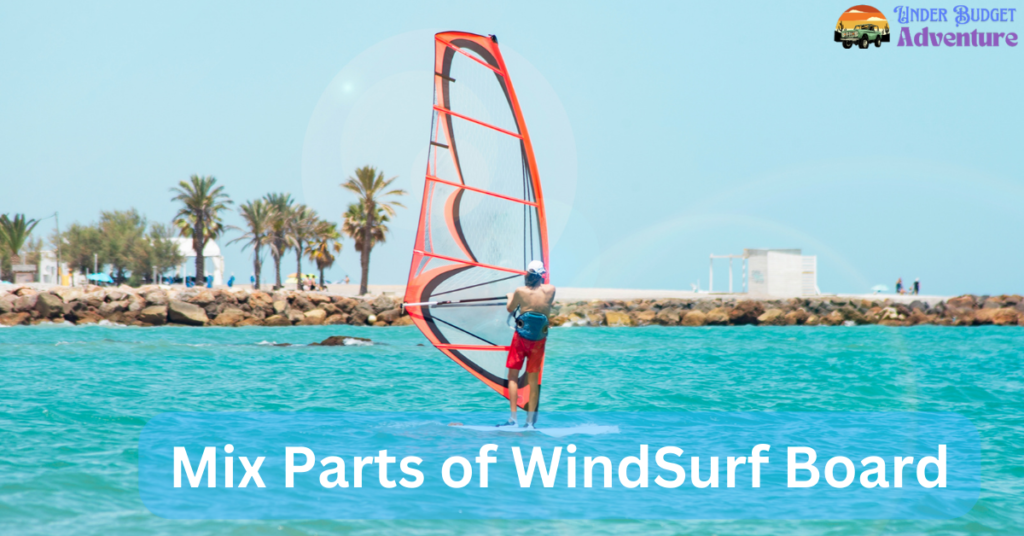
Let’s start with the mast extension—this often-overlooked piece can dramatically enhance your rig’s performance by allowing for greater sail height and improved power control. A high-quality mast extension not only optimizes your setup but also contributes to more efficient energy transfer from the sail to your board, which is essential in varying wind conditions.
Equally important are the mast base and uphaul system. The right mast base can provide unparalleled stability and control during those exhilarating moments on the water. Look for durable materials that offer a firm grip without adding excessive weight, ensuring you’re agile when adjusting your stance. Meanwhile, an effective uphaul simplifies sail retrieval after a fall, helping you get back into action quickly.
A valuable feature for both beginners and seasoned riders alike. Prioritizing these elements will greatly enhance your overall experience on the waves, allowing you to focus on what really matters: enjoying every second of windsurfing bliss!
Life Jacket or Buoyancy Aid
Just like Every important part – a life jacket or buoyancy aid stands out—not merely a regulatory requirement but a vital gear piece that ensures peace of mind on the water. Contemporary buoyancy aids are made to be comfortable and flexible, preserving your freedom of movement without making you feel heavy or restricted. This implies that you won’t have to worry as much about your own safety and may concentrate more on honing your talents.
As for boards and sails, there’s an exciting range tailored for different styles and skill levels. If you’re just starting out, consider an oversized board that offers better stability; it will help you build confidence as you learn to harness the wind’s power. If you want to Learn about skiing you can visit our skiing Category and Know each and every thing about skiing.
FAQ’s
What Equipment do I Need to Start Windsurfing?
If you want to start windsurfing, you’ll need a Surfing board, sail, mast, boom, and harness. It’s compulsory to have safety gear like a life jacket and other safety tools
How do I choose the right size sail?
Its size depends on your weight, your skill level, and wind and weather conditions. Lighter sails are better for beginners or lighter winds, on the other hand heavier sails suit experienced surfers in stronger winds.
Is Windsurfing Suitable for Beginners?
Absolutely Yes! You can learn surfing and . With the right equipment and guidance, anyone can enjoy windsurfing.
Do I need any Special Skills to Start Windsurfing?
Yes Swimming Skill is nececssary for safety. Other than that, enthusiasm and a willingness to learn are all you really need!
Summery
The Best Windsurfing Equipment can significantly enhance your overall experience on the water. From choosing the right board to selecting a sail that complements your skill level, each component plays a crucial role in your performance and enjoyment. It’s essential to consider factors such as durability, versatility, and ease of use when making your selections. With the right gear in hand, you’ll not only improve your skills but also create unforgettable memories riding the waves.

